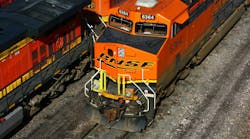Anti-Aging Procedure
As the economy continues to elicit cutbacks, daily newspaper headlines chronicle the degradation of U.S. water infrastructure. George Crombie, president of the American Public Works Assn. (APWA), spoke to Storm Water Solutions Associate Editor Elizabeth Lisican about how to deal with these critical issues in the face of so many obstacles.
Elizabeth Lisican: What is your overall outlook on aging water infrastructure today?
George Crombie: Let me go back in history a little bit. The Clean Water Act (CWA) was passed in 1972. When the act was passed, it provided funding—federal, state and local money—to build wastewater treatment plants across the country. Basically, secondary treatment is what occurred.
Over the past 30 years, many of those treatment plants are reaching a point where they’re going to need investments and upgrades—everything from energy improvements to processing to treatment. So that’s one area where I think the whole issue arises of looking at our infrastructure today and figuring out from a federal, state and local vantage point: How do we make the necessary investments in the future?
From a storm water point of view, I think secondary treatment was our challenge back in the early 1970s. I think our challenge in the 21st century is managing storm water. It’s going to be a lot more complex in many ways than the development of wastewater treatment plants in the past because then you had an end-of-pipe solution. With storm water you have storm water running off from the landscape. The questions are: How do you treat it? Who’s responsible? Who are the players that are involved? And that’s going to be a very complex issue.
Lisican: How do you believe utilities can tackle these challenges cost-effectively?
Crombie: If you look at a wastewater treatment plant, the big pieces of cost to running [it] are labor, energy and chemicals. Any time you can reduce energy in a wastewater treatment plant, it’s going to be a long-term investment with a significant payback. So new technology that you can invest in to reduce energy is going to be very significant for wastewater treatment plants as well as the whole water and wastewater industry. I’ve said many times that the green movement is not a fad but a real revolution on how we build in the future.
Lisican: Regionally, where do you see the most urgency for change?
Crombie: I think we’re going to have significant degradation of water quality across the country. The Chesapeake Bay is a perfect example. The biggest challenge in the Chesapeake Bay right now is storm water runoff and nutrients as well as minerals running off agricultural land, running off parking lots. It’s not the wastewater treatment plants that are causing nitrogen and phosphorous impacts to the Chesapeake Bay: It’s the actions of every homeowner, business, agriculture and all those that live within that watershed.
Lisican: What is APWA doing to help address water quality degradation?
Crombie: One of the things we have is our Water Resource Committee. We believe there is a real need to write a new water pollution plan as we did with the CWA. We believe that APWA and others that are involved with the industry, including environmentalists, need to sit down with the EPA [U.S. Environmental Protection Agency] and write a plan to manage water resources in the future in this country.
The current legislation in place, the funding, the grants, etc., is now reaching a point of, in my view, the Law of Diminishing Returns. We’ve reached the point now where we need new methods and new ideas on how to continue to improve water quality in the future.
Download: Here

